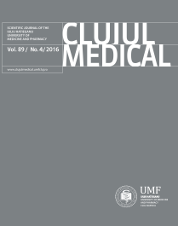Severe hemolytic disease of the premature newborn due to RH1 incompatibility: a case report
DOI:
https://doi.org/10.15386/cjmed-578Keywords:
Hemolytic disease of the newborn, allo-immunization, prevention, RH1Abstract
We report a case of dramatic outcome of severe haemolytic disease in a newborn due to RH1 incompatibility. A newborn with A RH1 blood group was admitted in the Mohammed V Military Teaching Hospital for the problem of hydrops fetalis associated with RH1 incompatibility. The blood group of his mother, aged 31, was AB RH1-negative and that of his 37 year old father was A RH1.The mother had a history of 4 term deliveries, 3 abortions, and 1 living child. There was no prevention by anti-D immunoglobulin postpartum. The mother‘s irregular agglutinin test was positive and the pregnancy was poorly monitored. The laboratory tests of the newborn showed a high total serum bilirubin level (30 mg/L) and macrocytic regenerative anemia (Hemoglobin=4 g/dL, mean corpuscular volume = 183 fL, reticulocytes count =176600/m3). The blood smear showed 1256 erythroblasts per 100 leukocytes, Howell–Jolly bodies and many macrocytes. The direct antiglobulin test was positive. He was transfused with red blood cell concentrates and treated with conventional phototherapy. The evolution was unfavourable; he died three days after the death of his mother. The monitoring of these high-risk pregnancies requires specialized centers and a close collaboration between the gynaecologist and the blood transfusion specialist to strengthen the prevention, as well as clinico-biological monitoring in patients with a history of RH1 fetomaternal alloimunization.
Downloads
Additional Files
Published
How to Cite
Issue
Section
License
The authors are required to transfer the copyright of the published paper to the journal. This is done by agreeing to sign the Copyright Assignment Form. Whenever the case, authors are also required to send permissions to reproduce material (such as illustrations) from the copyright holder.

The papers published in the journal are licensed under a Creative Commons Attribution-NonCommercial-NoDerivatives 4.0 International License.

